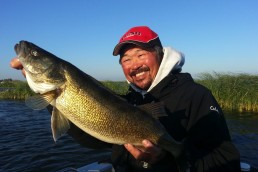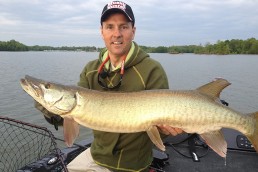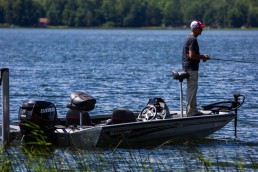Muskies on the Edge
SHARE THIS POST
The wind had been blowing steadily from the southwest into one of my favorite spots. It was a large submerged bar with weeds that dropped off into deep water. I held the boat off the deep edge as we made long casts over the top of the bar. With the wind blowing into the shallow cover I had to make sure to keep the boat out farther, in case we hooked up with a lunge. As we approached one of our favorite waypoints, I held the boat in position for a few extra casts.
I launched my Cowgirl spinner over the cover and began cranking fast with my Shimano Tranx reel. I could see the spinner flashing a foot below the surface as it cruised across the cover like a missile. As the bucktail cleared the cover and entered the open water, my rod doubled as the giant muskie inhaled the lure. The muskie jumped and thrashed at boatside and soon was sitting in our StowMaster net. My boat partner and I had seen this scenario several times, but it’s something that never ceases to get the blood pumping and the adrenaline rushing. After a few quick pictures the muskie was released and we continued fishing.
This scenario may seem routine, but there are a few things to consider that can make the difference between catching a muskie or not. The first is to understand that when fishing over shallow cover, the strikes often occur once the lure clears that shallow cover and enters the edge of open water. So, if your boat is too close to the cover, you may miss the opportunity to trigger a strike. You really need to be aware of the location of the edge and keep your boat in position where you are not too close to the edge.
Second, you’ll need waypoints to keep you in position along the edge. I use my Lowrance Live12 to mark my waypoints and boat control path along the edge. Also, whenever I catch a muskie or have a follow, I save a waypoint to make sure the next time I fish the spot that I hold the boat in position and make a few more casts. Often times, it’s finding those “special” spots and being able to make multiple casts to those areas that makes the difference between simply fishing a spot and catching a muskie.
Although the edge discussed above was the deep edge, there can be multiple edges on a spot, and any one of them can, at times, hold muskies. Besides the two deep edges, I focus on the edges between hard-bottom shallow spots on a large flat and the weeds (often known as weed pockets) or edges between different weed types. On some waters you find a distinct difference between some shallow and deeper weed cover, and that edge can hold muskies.
Are you enjoying this post?
You can be among the first to get the latest info on where to go, what to use and how to use it!
I am always trying to determine not only what spots hold muskies, but really have an awareness regarding what edge is holding muskies. If it’s the shallow pockets or the transition between weed types, it may require me to move my boat shallower to more precisely work that edge and not worry about the deeper edge. Sometimes it’s just not possible to cover all of the edges from a deep-water boat position. You just need to keep an open mind and adjust when the muskies start showing up.
One final edge to consider is the inside edge between the shoreline and weed cover. This edge seems to get better in late summer or early fall, as the nights get cooler, but it’s always something worth checking when the deeper edges aren’t producing. It’s also an excellent edge to work early in the morning. There’s really something special about fishing the inside edge with a Topraider at dawn. Like the outside edge, the inside edge will also have special features or turns that hold more muskies, and you need to mark them with your GPS.
Muskies are apex predators and use the edges to find food and as natural ambush points. Sure, I first focus on the deep edges, however, also be aware of the shallow weed pockets, weed transition edges, and of course, the inside edge. Don’t keep pounding the deep edge if nothing is happening. And if you get a strike from the top of a flat, it’s worth exploring to find out why.
Finally, never ignore the inside, as you might be surprised what you find.
MWO
SHARE THIS POST
You may also like...
Did you enjoy this post?
You can be among the first to get the latest info on where to go, what to use and how to use it!
Jim Saric
Jim Saric is a Legendary Angler in the Freshwater Fishing Hall of Fame, the host and executive producer of The Musky Hunter television series, editor at large of Musky Hunter magazine, a seven-time muskie tournament winner, and a contributing writer for numerous other publications.



